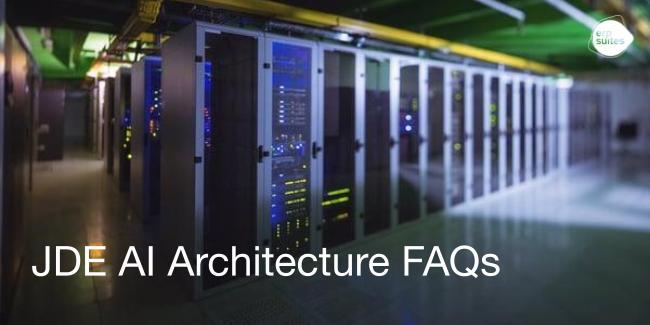Three Ways Implementing GenAI + IoT Can Help Your Bottom Line
April 1st, 2024
3 min read
.png?width=960&height=540&name=Blog%20Images%20(29).png)
Putting AI to work with your IoT and gleaning insights from that powerful combination through JD Edwards is the way of the future. Generative AI is everywhere – so hot right now – and deciding to implement its usage in your workplace is a safe bet on a relevant future.
Here are three ways implementing AI in IoT are beneficial for you and your company.
1. Being Predictive Means Being Proactive
For most manufacturers, equipment and assets are the lifeblood of their operations. If keeping their machinery and equipment operating at optimal efficiency is the difference between making millions of dollars in a day or losing millions of dollars in a day, that manufacturer is incentivized to avoid the tenfold downstream impacts of those outages.
IoT technologies are enabling manufacturers to gain unprecedented insights into asset performance through continuous equipment monitoring. By integrating sensor data streams with AI and machine learning capabilities, companies can take predictive maintenance to the next level. AI models can be trained on historical sensor data to recognize patterns indicating potential failures.
For example, an IoT sensor can be placed on a piece of machinery to continuously record and therefore monitor its vibrations and temperatures. By setting probability thresholds for when patterns in those areas are detected, notifications can automatically trigger work orders and maintenance planning, directly in JD Edwards. AI can even make predictive quality control decisions, by reading documents generated from the data gathered before those machines generate more product while operating under suboptimal conditions.
The problems caught by the AI via the IoT devices and sensors don’t even have to be huge. But catching them can help direct attention to a potential issue, get ahead of the problem it could develop into, and avoid the issue altogether. This kind of condition-based maintenance is essentially the ROI on the cost savings in the long run.
Let’s take it one step further. More than just performing automatic factory data collection, implementing Ai with your IoT can act as a real asset management tool that keeps your plant in order long-term. Some supplemental data procured, that’s not necessary for immediate action-taking, can capture information that can be quite valuable in other areas of your business further down the line.
2. Taking Stock of Everything
The predictive capabilities of implementing AI with your warehouse IoT devices keep your long-term production in check. But what about the more immediate warehouse needs? Manufacturing thrives on achieving a delicate balance between having enough materials on hand to meet production demands and avoiding excessive inventory that ties up capital and storage space.
Using real-time data collected by AI from connected shelves and warehouses outfitted with IoT devices on the daily leads to optimized inventory levels and prevents stockouts. After all, data is the oil that fuels long-term success.
Say a factory utilizes smart shelves equipped with weight sensors. These sensors constantly monitor inventory levels of critical components. As parts are removed for production, the weight sensors transmit real-time data to your AI, which feeds it back into JD Edwards. This AI analyzes the data alongside historical usage patterns and lead times. If inventory dips below a predefined threshold, the AI automatically triggers an order for new parts. This ensures a smooth production flow without the risk of stockouts that could halt assembly lines.
The benefits extend beyond preventing stockouts. By analyzing past usage data, the AI can predict future needs with greater accuracy. This allows for optimized ordering quantities, eliminating the need for overstocking to safeguard against potential fluctuations. Additionally, the AI can factor in supplier lead times, ensuring parts arrive just in time for production, minimizing storage costs and the risk of obsolescence for sensitive materials. This data-driven approach to inventory management streamlines operations, reduces waste, and ultimately, bolsters a manufacturer's bottom line.
3. Stay in Demand
Traditionally, demand forecasting has relied on historical sales data and educated guesses, often leading to inaccurate predictions, and missed opportunities. However, AI, combined with the power of JD Edwards and connected IoT devices, can significantly improve forecasting accuracy.
Imagine a furniture manufacturer that utilizes AI to analyze past sales data from JDE. This analysis reveals trends in popular furniture styles, materials, and color preferences. Additionally, the company partners with smart home device providers to collect real-time customer data. This data might show an increase in connected lightbulbs being purchased, potentially indicating a move to a new home or a desire to redecorate.
By feeding this combined data set into an AI algorithm, the manufacturer can generate highly accurate forecasts, keeping that supply chain from derailing. They can anticipate a rise in demand for specific furniture types, like sectionals or dining tables, and adjust production accordingly. This ensures they have enough in stock for the upcoming surge in demand, minimizing the risk of lost sales. The result is a manufacturer that can operate more efficiently, avoid costly overstocking, and ultimately deliver a more satisfying customer experience.
Make AI Work for You
The time is now. By implementing these technologies, you can ensure efficient operations, minimized costs, and ultimately, a thriving business. Our team of experts is here to guide you through every step of the integration process.
Contact us today to unlock the full potential of this revolutionary triumvirate.
Leyla Shokoohe is an award-winning journalist with over a decade of experience, specializing in workplace and journalistic storytelling and marketing. As content manager at ERP Suites, she writes articles that help customers understand every step of their individual ERP journey.



.png?width=650&height=325&name=Blog%20Images%202_1%20(4).png)
.png?width=650&height=325&name=Blog%20Images%202_1%20(5).png)
.png?width=650&height=325&name=Blog%20Images%202_1%20(3).png)
.png?width=650&height=325&name=Blog%20Images%202_1%20(2).png)
.png?width=650&height=325&name=Blog%20Images%202_1%20(1).png)
.png?width=960&height=540&name=Blog%20Images%20(96).png)

.png?width=960&height=540&name=Blog%20Images%20(90).png)
.png?width=960&height=540&name=Blog%20Images%20(88).png)
.png?width=960&height=540&name=Blog%20Images%20(87).png)
.png?width=960&height=540&name=Blog%20Images%20(86).png)
.png?width=960&height=540&name=Blog%20Images%20(85).png)
.png?width=960&height=540&name=Blog%20Images%20(83).png)
.png?width=960&height=540&name=Blog%20Images%20(82).png)
.png?width=960&height=540&name=Blog%20Images%20(80).png)